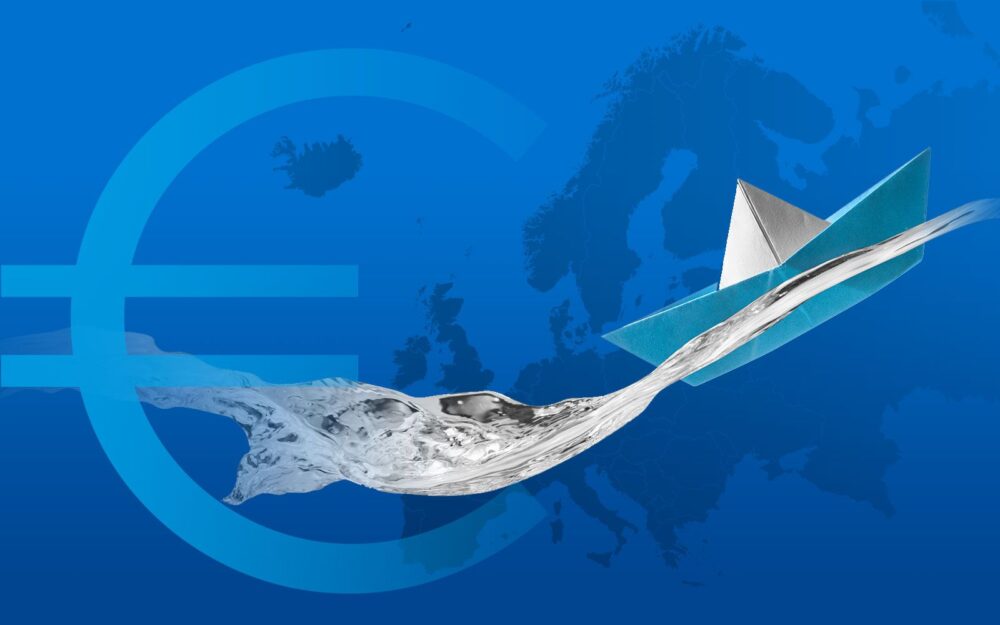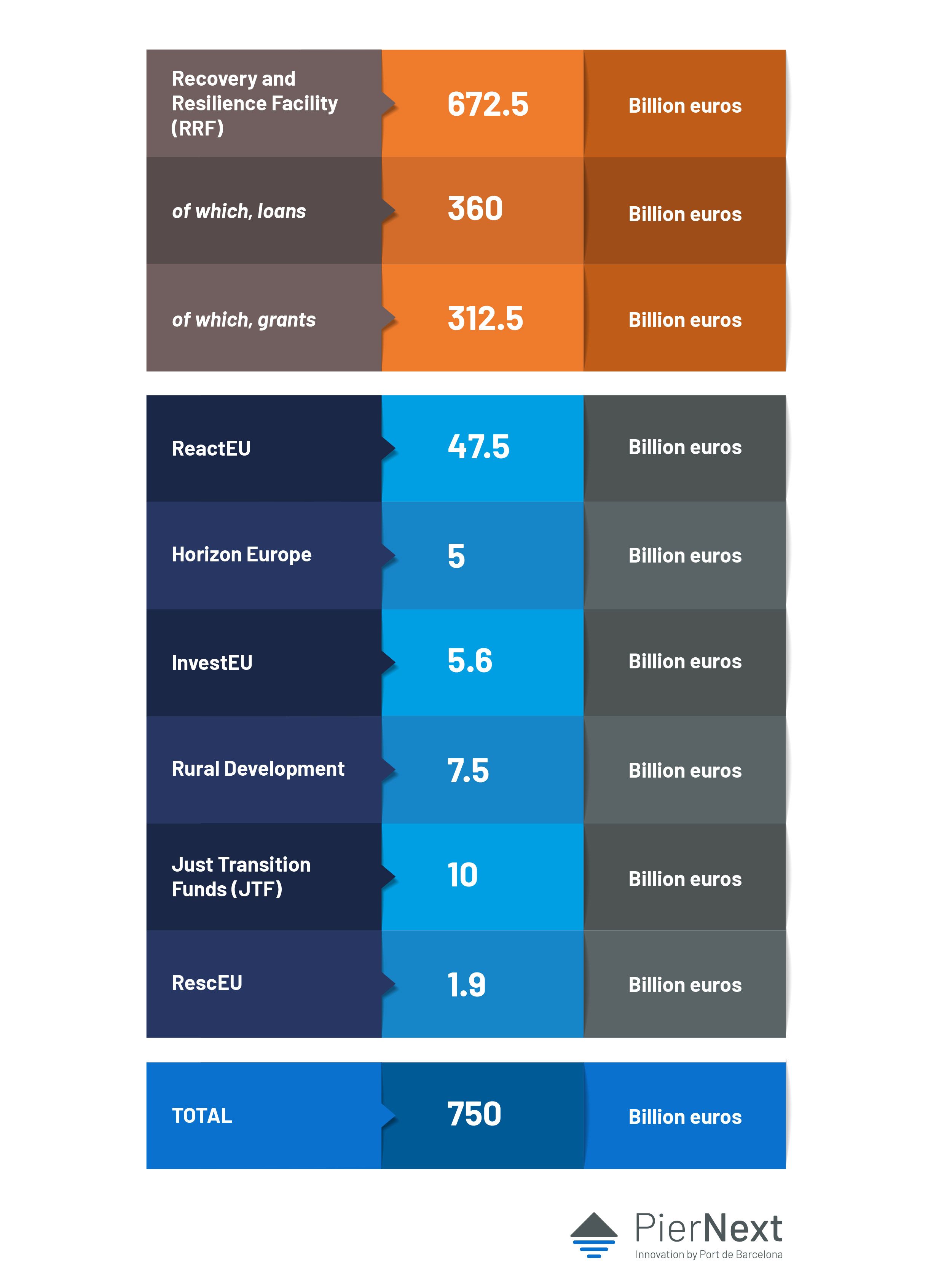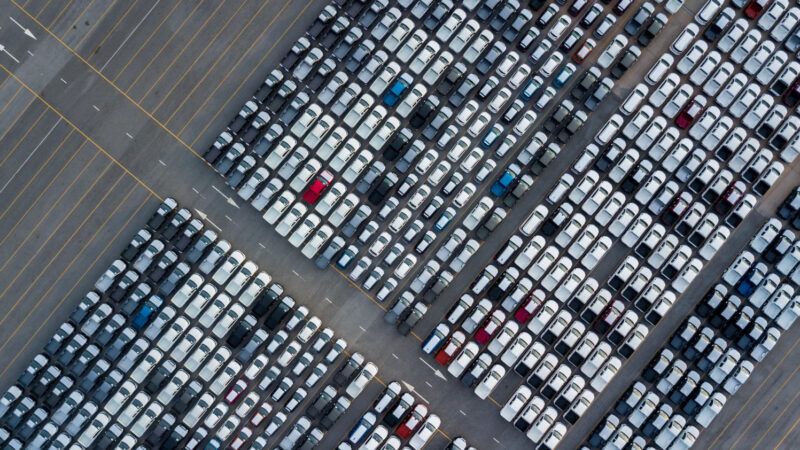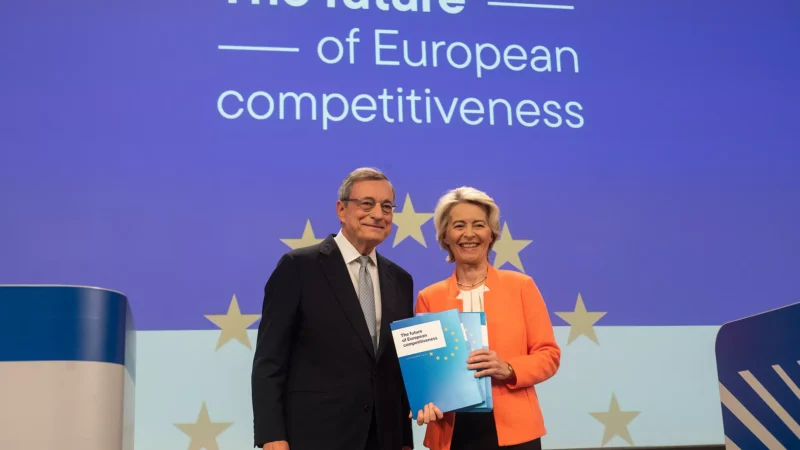 Spain expects to receive €140 billion from the Next Generation EU plan. (GettyImages)
Spain expects to receive €140 billion from the Next Generation EU plan. (GettyImages)
Next Generation EU: Europe’s recovery plan is based on innovation
Spain expects to receive €140 billion, €72 billion of which are non-repayable, from Next Generation EU, a recovery plan endowed with €750 billion approved by the European Council in the peak of the Covid-19 pandemic. In this article we outline how these funds will be structured. Some of the topics likely to receive these aids are precisely those which the ports have been working on for the last years, such as sustainability and digitalisation. Port innovation as a path towards recovery.

Carles Rúa is the Chief Innovation Officer at the Port de Barcelona and Director of the Master’s degree in Executive in Supply Chain Management at the UPC.
 Spain expects to receive €140 billion from the Next Generation EU plan. (GettyImages)
Spain expects to receive €140 billion from the Next Generation EU plan. (GettyImages)
What exactly is the Next Generation EU?
A temporary fund created by the European Union (EU) to alleviate the economic and social losses caused by the pandemic. And this is not just any fund, the same way this is not an average crisis.
It will distribute €750 billion between loans and credits. But not at any price or to just mitigate the effects of the economic meltdown. Its objective is to reduce the direct economic and social impact of the pandemic, that is, to make Europe greener, more digital, more resilient and more adapted to current and future challenges.
These funds will be added to the regular EU budgets, which form the so-called "Multiannual Financial Framework 2021-2027" valued at nearly €1.1 trillion. The sum of both generates a total budget for the next few years of €1,8 trillion, an amount never seen before.
The Recovery and Resilience Facility (RRF), a newly created instrument agreed by Parliament and the European Council on December 18, 2020, will be allocated the largest part of these funds, a total of €672.5 billion. Its objective is to mitigate the direct economic and social impact of the pandemic. The different states of the EU are now working on their recovery and resilience plans to access these funds.
The RRF funds are assigned in two sections: 70% based on economic indicators prior to the health emergency and the remaining 30% will be allocated in 2022, once the data on the economic evolution between 2020 and 2022 is available. It is also worth mentioning that of the total RRF funds, around €360 billion will be for loans and around €312 billion million euros in the form of non-repayable grants.
But the Next Generation EU also finances other programs, some of the new like REACT-EU and increases the budget of some existing programs, like Horizon Europe, InvestEU or the Just Transition Fund.
In terms of economic weight, React-EU is, for example, the second program of those mentioned above. The aim is to continue and expand the measures taken to respond to the health emergency adopted during the crisis. This budget will be at the disposal of three existing programs, such as the European Regional Development Fund (ERDF), the European Social Fund (ESF) or the Fund for European Aid to the Most Deprived (FEAD). Despite they operate as structural funds, they will be more flexible in its execution. They are scheduled for the 2021 and 2022 fiscal years.
Therefore, we are talking about temporary instruments that will have to be allocated mainly in the short term. In fact, in Spain, the 2021 General State Budget already includes about €26.6 billion of resources from the Next Generation EU: about €24.2 billion euros correspond to the RRF and about €2.4 billion to React-EU.
The complete breakdown of Next Generation EU funds is shown in the following table:

What is its mission?
In terms of their allocation, the mission of the funds is to boost investment to mitigate the effects of the pandemic with a threefold goal: to increase aggregate demand; to support the countries most affected by the crisis and to seek European cohesion; and strengthen the EU's economic growth potential. But in addition to this generic statement, much of the fund's thematic orientation is pre-established.
Thus, more than 50% of the amount will be allocated to modernization. For example, promoting the Horizon Europe research and innovation program, or the Just Transition Fund and the Digital Europe program in order to promote a just climate and digital transition or through the Recovery and Resilience Fund itself, the RescEU program or a new health program, EU4Health in order to ensure European recovery and resilience and prepare it for the future.
There is also a special focus on climate change, which will absorb 30% of European funds, the modernization of cohesion policies and the common agricultural policy or the protection of biodiversity, and gender equality.
What is the Spanish answer?
Spain is, after Italy, the European country with the highest allocation of Next Generation EU funds. According to the indicators that will be applied, Spain would receive approximately €60 billion from the RRF in non-repayable transfers and could access a maximum volume of €80 billion in loans. As for the React-EU fund, Spain will receive just over €12 billion for its implementation in the period 2021-22.
Given that 70% of the grants awarded by the RRF will have to be committed by the European Commission in 2021 and 2022, the same period when the REACT-EU will also have to be executed, it is very urgent to prioritise the projects where these funds will be invested.
On October 7, 2020, the Spanish government, under the title "España Puede", presented the Recovery, Transformation and Resilience Plan that will guide the implementation of about €72 billion in the next three years (approximately 50 % of the resources that Europe makes available to Spain in regards to the Next Generation EU).

How will it affect the ports?
If we analyze the forecast of the dedication of the Spanish budgets to the different policies for the next three years, according to the Plan “España Puede”, resilient infrastructures and ecosystems will take 12.2% of the budget, just and inclusive energy transition 8.9%, and the modernization and digitalisation of the fabric, industry and SMEs 17.1%. The three areas clearly interact with the topics ports are currently developing.
This plan is inspired by the Climate Change Agenda, the 2030 Agenda and the United Nations Sustainable Development Goals and is based on four pillars: Ecological Transition, Digital Transformation, Gender Equality and Social and Territorial Cohesion, structured around 10 tractor policies:
- Urban and rural agenda, the fight against rural depopulation and agricultural development.
- Pact for science and innovation and strengthening the capabilities of the National Health System.
- Resilient infrastructures and ecosystems
- Education and knowledge, lifelong learning and capacity building.
- A just and inclusive energy transition
- The new care economy and employment policies
- An Administration for the 21st century.
- Promotion of the culture and sports industries.
- Modernisation and digitalisation of the ecosystem of our companies.
- Modernisation of the tax system for inclusive and sustainable growth.
To get a clearer idea of how these funds will be distributed, we can review the allocation between ministries as shown in the 2021 General State Budget.
Thus, with regards to the RRF, the Ministry of Ecological Transition and Demographic Challenge will concentrate 28% of the total, which focuses on the generation of renewable energy, the promotion of electricity networks and the deployment of an energy storage network.
The Ministry of Transport, Mobility and Urban Agenda will concentrate 21% of the total, which will be allocated to housing rehabilitation, sustainable mobility plans and related infrastructure.
The Ministry of Economy and Digital Transformation has allocated 15% with the aim of digitizing the productive fabric, promoting digital connectivity and promoting the digitization of the Public Administration.
The rest of the resources are distributed among the rest of ministries (Education and Vocational Training, 8%; Industry, Trade and Tourism, 7%; Work and Social Economy, 5%; Science and Innovation, 5%; and Social Rights and Agenda 2030, 4%).
Moreover, the nearly €2.5 billion of budget allocated to the Estate Budget corresponding to the React-EU program will be managed directly by the Ministry of Health.
Un dels aspectes més rellevants del Pla és la creació d’una nova figura de col·laboració públic-privada, els PERTE (Projectes Estratègics per a la Recuperació i Transformació Econòmica), com a instrument per a l'execució dels projectes d'inversió.
One of the most relevant aspects of the Plan is the creation of a new figure of public-private collaboration, the Strategic Projects for Economic Recovery and Transformation (PERTEs, in Spanish), as an instrument for the execution of investment projects.
The PERTEs want to reflect, at national level, the main projects of interest for the whole of Europe and will include tractor projects that have the capacity to either make a structural transformation on strategic sectors or that include disruptive and ambitious elements of research and innovation.
In addition, in order to identify projects and new lines of action that contribute to the design and sizing of these funds, the ministries involved have launched "expressions of interest" in order to identify the market situation, the possible entities (companies , associations, consortiums, public entities) with an interest in developing projects or initiating new lines of action, as well as identifying the most relevant aspects of these projects and actions.
The information collected through these “expressions of interest” should be used to define the strategic lines of action and their funding or support mechanisms, although participation in these expressions of interest is not considered a precondition or a condition for future access to finance.
The three areas with the highest budget allocation of the “España Puede” plan clearly interact with the topics ports are currently developing
But where does the money come from?
In addition to the usual EU resources, a new national contribution based on non-recycled plastic packaging waste has been introduced since 1 January 2021. In addition, the EU also plans to apply for loans in the markets at more favorable rates than those available to member states, given its triple A credit ratio, and will redistribute these loans among them.
On the other hand, before June 2021, the Commission must present new revenue formulas, including those related to a carbon adjustment mechanism, a digital tax and the emissions trading scheme in the EU.
And, before June 2024, proposals will have to be made on new taxes related to financial transactions, a contribution linked to the business sector or a common tax base on corporation tax.
The Next Generation EU represents a great opportunity to emerge stronger from this deep crisis caused by the Covid-19 pandemic, but at the same time it is also a huge challenge.
Spain has proved in the past that it has not been effective managing European aid. Several experts warn about the lack of human resources to manage the volume of applications that will be associated with these funds as well as the excessive existing administrative bureaucracy (especially in aspects such as public procurement or the management and supervision of public aid) or the dilation of many administrative deadlines. While the government is already developing measures to make fund management more agile, it remains to be seen whether these are sufficient to make the most of these resources.
All these limiting aspects, if not resolved promptly, could slow down the resources that will eventually reach our country.





